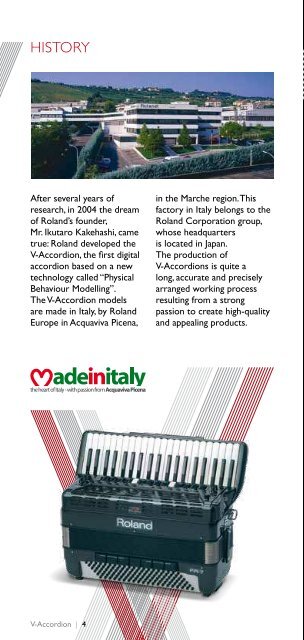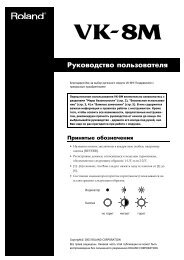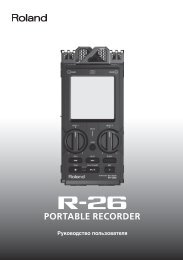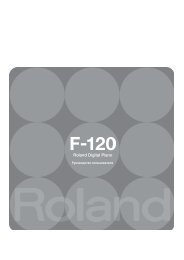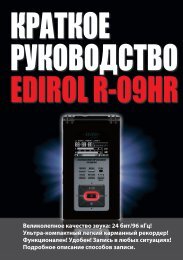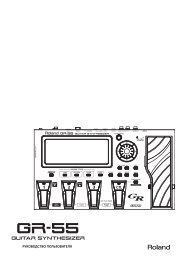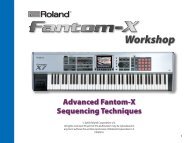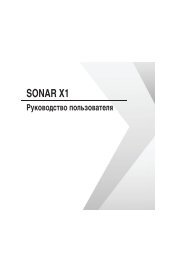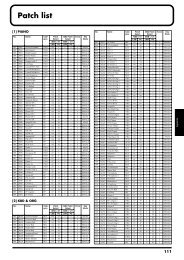V-Accordion Leaflet - Roland
V-Accordion Leaflet - Roland
V-Accordion Leaflet - Roland
Create successful ePaper yourself
Turn your PDF publications into a flip-book with our unique Google optimized e-Paper software.
HISTORY<br />
THE TECHNOLOGY<br />
After several years of<br />
research, in 2004 the dream<br />
of <strong>Roland</strong>’s founder,<br />
Mr. Ikutaro Kakehashi, came<br />
true: <strong>Roland</strong> developed the<br />
V-<strong>Accordion</strong>, the first digital<br />
accordion based on a new<br />
technology called “Physical<br />
Behaviour Modelling”.<br />
The V-<strong>Accordion</strong> models<br />
are made in Italy, by <strong>Roland</strong><br />
Europe in Acquaviva Picena,<br />
in the Marche region. This<br />
factory in Italy belongs to the<br />
<strong>Roland</strong> Corporation group,<br />
whose headquarters<br />
is located in Japan.<br />
The production of<br />
V-<strong>Accordion</strong>s is quite a<br />
long, accurate and precisely<br />
arranged working process<br />
resulting from a strong<br />
passion to create high-quality<br />
and appealing products.<br />
PBM (Physical Behaviour Modelling)<br />
At the heart of the V-<strong>Accordion</strong> is <strong>Roland</strong>’s new, proprietary<br />
PBM sound engine and modelling technology. Physical<br />
Behaviour Modelling uses complex algorithms to accurately<br />
recreate an acoustic accordion’s sound characteristics. The<br />
result is a faithful simulation of the actual physical behaviour<br />
and expressive nuances of an acoustic instrument.<br />
Bellows Movement Modelling<br />
PVA (Pressure Variant Amplifier)<br />
This function controls the dynamics of each reed sound, based<br />
on the high-resolution bellows pressure sensor. Starting and<br />
stopping, hysteresis threshold, inertia, expression curve, and<br />
volume are all individually programmed to reproduce a true<br />
free-reed sound.<br />
VOLUME<br />
Hysteresis Thresholds<br />
Reed Inertia<br />
BELLOWS PRESSURE<br />
Off<br />
On<br />
PVF (Pressure Variant Filter)<br />
The tone colour of each reed sound is also shaped in<br />
real-time by the dedicated DSP (Digital Signal Processor),<br />
responding accurately to each expressive playing nuance<br />
applied by the bellows.<br />
PVP (Pressure Variant Pitch)<br />
The pitch of each simulated reed is varied individually.<br />
As the bellows is pushed<br />
or pulled more forcefully,<br />
the sound becomes fatter<br />
and richer, because each<br />
simulated reed exhibits a<br />
“natural” tendency to go out<br />
of tune.<br />
Expression Curve<br />
Musette Tuning<br />
Based on extensive research of the different tuning types<br />
used throughout the world the V-<strong>Accordion</strong>’s note-by-note<br />
micro-tuning feature allows a V-<strong>Accordion</strong> to authentically<br />
reproduce many different accordion types for various genres<br />
of music.<br />
VOLUME<br />
Hz<br />
In Tune<br />
2’ 2/3<br />
8’<br />
16’<br />
16’<br />
8’<br />
2’ 2/3<br />
BELLOWS PRESSURE<br />
BELLOWS PRESSURE<br />
V-<strong>Accordion</strong> | 4<br />
V-<strong>Accordion</strong> | 5


